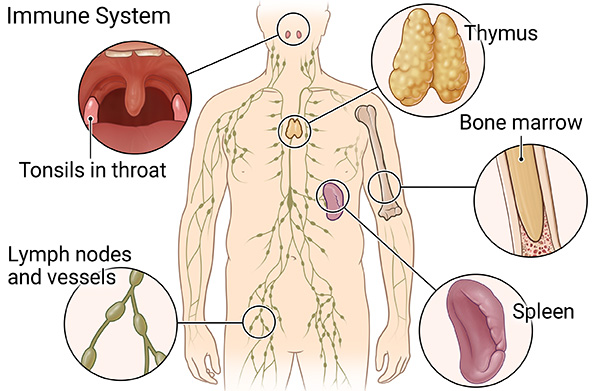Allergies and the Immune System
Allergic disease is one of the most common chronic health conditions in the world. Allergy symptoms can range from mild to a serious life-threatening allergic reaction (anaphylaxis). People with a family history of allergies have a higher risk of allergic disease. Types of allergic diseases include:
-
Hay fever
-
Eczema
-
Hives
-
Asthma
-
Food allergy
Allergic reactions start in your immune system. If you are allergic to a substance such as dust, mold, or pollen and you come into contact with it, your immune system may overreact. It may make antibodies that attack the substance. Something that causes an allergic reaction is called an allergen. They can cause:
-
Wheezing
-
Itching
-
Runny nose
-
Watery or itchy eyes
-
Other symptoms
What is the immune system?
The goal of the immune system is to defend your body. It works to keep harmful bacteria, viruses, and fungi out of your body. It works to kill any of these that get into your body. The immune system is made up of a complex network of cells and organs. All of these work to protect your body from infection.

The organs are called the lymphoid organs. They affect growth, development, and the release of white blood cells called lymphocytes. The blood vessels and lymphatic vessels carry the lymphocytes around the body. Each lymphoid organ plays a role in making and releasing lymphocytes.
Lymphoid organs include:
-
Adenoids. These are 2 glands located at the back of the nasal passages.
-
Appendix. This is a small tube that is connected to the large intestine.
-
Blood vessels. These are the arteries, veins, and capillaries through which blood flows.
-
Bone marrow. This is the soft, fatty tissue found in bone cavities.
-
Lymph nodes. These are small organs shaped like beans. They are located throughout the body. They are connected through the lymphatic vessels.
-
Lymphatic vessels. This is a network of channels throughout the body that carries lymphocytes to the lymphoid organs and bloodstream.
-
Peyer patches. This is lymphoid tissue in the small intestine.
-
Spleen. This is a fist-sized organ located in the belly (abdomen).
-
Thymus. This is an organ with 2 lobes in the chest. It lies in front of the trachea behind the breastbone.
-
Tonsils. These are 2 oval masses in the back of the throat.
How does a person become allergic?
Common allergic reactions, such as hay fever, certain types of asthma, and hives are linked to an antibody made by the body called immunoglobulin E (IgE). Each IgE antibody can be very specific. This means it reacts to certain pollens and other allergens. For example, a person can be allergic to 1 type of pollen, but not another.
Allergens can be inhaled, ingested, or enter through the skin. When a person is exposed to an allergen, the body starts making a lot of similar IgE antibodies. The next contact with the same allergen may lead to an allergic reaction. Symptoms of an allergic reaction will vary. They depend on the type and amount of allergen that a person is exposed to and how the body's immune system reacts to that allergen.
Allergies can affect people of any age, gender, race, or socioeconomic status. Allergies are more common in children. But they may occur at any age. Allergic reactions may go away for many years and then come back.
What is anaphylaxis?
Anaphylaxis is a severe, life-threatening reaction to certain allergens. Anaphylaxis may:
-
Happen within minutes or up to an hour or more after contact with allergens
-
Cause body tissues to swell, including tissues in the throat
-
Cause a sudden drop in blood pressure (anaphylactic shock)
Other symptoms may include:
-
Itching, red rash and hives over most of the body
-
Feeling warm
-
Swelling of the throat and tongue or tightness in throat
-
Trouble breathing
-
Dizziness
-
Headache
-
Pain or stomach cramps
-
Nausea, vomiting, or diarrhea
-
Shock
-
Fainting
-
Feeling light-headed
-
Anxiety
-
Chest tightness
-
Abnormal heart rate (too fast or too slow)
Anaphylaxis is most often caused by an allergic reaction to 1 of these:
-
Medicine
-
Food
-
Insect venom
-
Allergen extract
-
Latex
Many people with allergies and a risk of anaphylaxis carry an emergency anaphylaxis kit. This kit has epinephrine, a medicine used to treat severe allergic reactions. Ask your healthcare provider if you need epinephrine, such as an autoinjector or nasal spray. They can teach you how and when to use it.